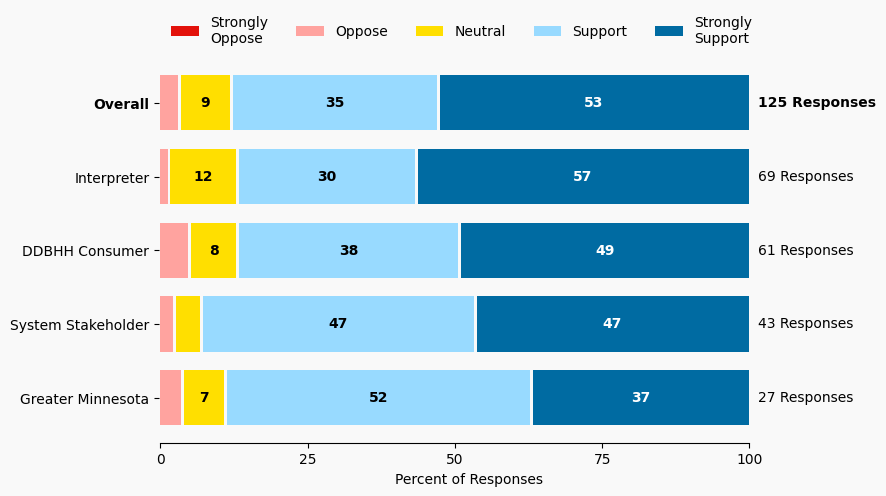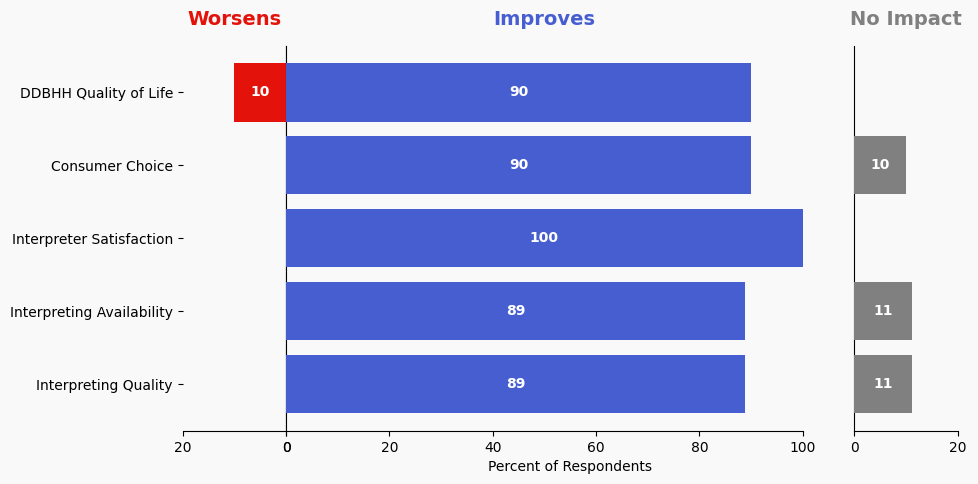60 Regulate the Use of Video Remote Interpreting (VRI) in Critical Settings
Issue: VRI is often stated as the only choice a DDBHH Minnesotan has for their communication access. Budget and lack of awareness often drives provider decisions to make contracts that only offer VRI.
Proposed Solution: To build upon and reinforce the ADA, Commission work with a coalition to pursue legislation in Minnesota that prioritizes DDBHH citizens preferences regarding VRI usage, particularly in areas that impact life, health and freedom such as medical, mental health and legal settings. Currently, providers of services have been increasingly entering contracts and establishing policies that prioritize VRI without consulting with DDBHH consumers. Legislation changes would require service providers to consult with DDBHH citizens prior to determining the use of VRI or on-site services. Legislation would force providers to enter into contracts that allow for both onsite interpreting and VRI, as well as developing procedures for ensuring DDBHH Minnesotans have input on their communication access.
Expected outcome: DDBHH citizens could receive greater access to critical areas for well-being and freedom. Interpreters who work in these specialized settings would have greater confidence that the format of the interpreting the consumer is receiving is meeting the consumers’ needs.
Who is impacted: Consumers, interpreters
Timeline: 6 months

Summary of Support Image Description
The stacked bar charts show how respondents rated their level of support and the total number of responses. The percentage for the five support levels is shown from left to right: Strongly Oppose (Dark Red), Oppose (Light Red), Neutral (Yellow), Support (Light Blue), and Strongly Support (Dark Blue).
Respondents may identify with multiple subgroups. The overall level of support is:
Overall
Strongly Oppose: 0%
Oppose: 3%
Neutral: 9%
Support: 35%
Strongly Support: 53%
Click to see the detailed image description for each subgroup.
Interpreter
Strongly Oppose: 0%
Oppose: 1%
Neutral: 12%
Support: 30%
Strongly Support: 56%
Greater Minnesota
Strongly Oppose: 0%
Oppose: 4%
Neutral: 7%
Support: 52%
Strongly Support: 37%
DDBHH Consumer
Strongly Oppose: 0%
Oppose: 5%
Neutral: 8%
Support: 38%
Strongly Support: 49%
System Stakeholder
Strongly Oppose: 0%
Oppose: 2%
Neutral: 5%
Support: 47%
Strongly Support: 47%
Overview of Respondents Opting for In-Depth Solution Analysis
After indicating their support level, 8% of the 125 respondents opted in to further assess whether the solution would worsen or improve on five metrics. Of the opt-in reviewers (10 respondents), 50% supported the solution, 30% were neutral on the solution, and 20% opposed the solution.
The remaining 115 respondents did not opt in to further assess the solution. Of these people, 91% support the solution, 6% were neutral on the solution, and 1% opposed the solution.
Reviewer Evaluation of Solution Effectiveness

Solution Effectiveness Image Description
The stacked bar charts show how respondents assessed the effectiveness of this solution based on five metrics. For each metric, the percentage of respondents is shown from left to right: Worsens (Red), Improves (Blue), No Impact (Gray).
DDBHH Quality of Life
Makes It Worse 10%
Makes It Better 90%
No Impact 0%
Interpreter Satisfaction
Makes It Worse 0%
Makes It Better 100%
No Impact 0%
Consumer Choice
Makes It Worse 0%
Makes It Better 90%
No Impact 10%
Interpreting Availability
Makes It Worse 0%
Makes It Better 88%
No Impact 11%
Interpreting Quality
Makes It Worse 0%
Makes It Better 88%
No Impact 11%
Reviewer Feedback and Insights
Interpreter
Comments from Interpreters emphasize that the DDBHH individual should have the final decision on whether VRI is permitted, but express support for the use of Video Remote Interpreting (VRI) particularly for interpreters with specialized training. One comment mentions the importance of a review process for patients to assess the quality of the interpreting experience.
Deaf, DeafBlind, Hard of Hearing
Comments from DDBHH Consumers emphasize the importance of providing patients the choice between VRI and in-person interpreting services based on their comfort and needs.
System Stakeholder
Comments from System stakeholders raise concerns about the appropriate uses of VRI, suggesting it should only be used when absolutely necessary. One comment places emphasis on ensuring that the DDBHH patient holds the final decision regarding the use of VRI.
PREVIOUS SOLUTION
59 Enhance Broadband Internet Access in Greater Minnesota
Issue: Broadband internet access in rural areas is often insufficient for high quality video capabilities needed for effective interpreting via video.
NEXT SOLUTION
61 Secure Funding for a Rural Interpreter Mentoring/Professional Development Program
Issue: Limited opportunities for Greater Minnesota interpreters who want to advance their skills.
Leave a Reply